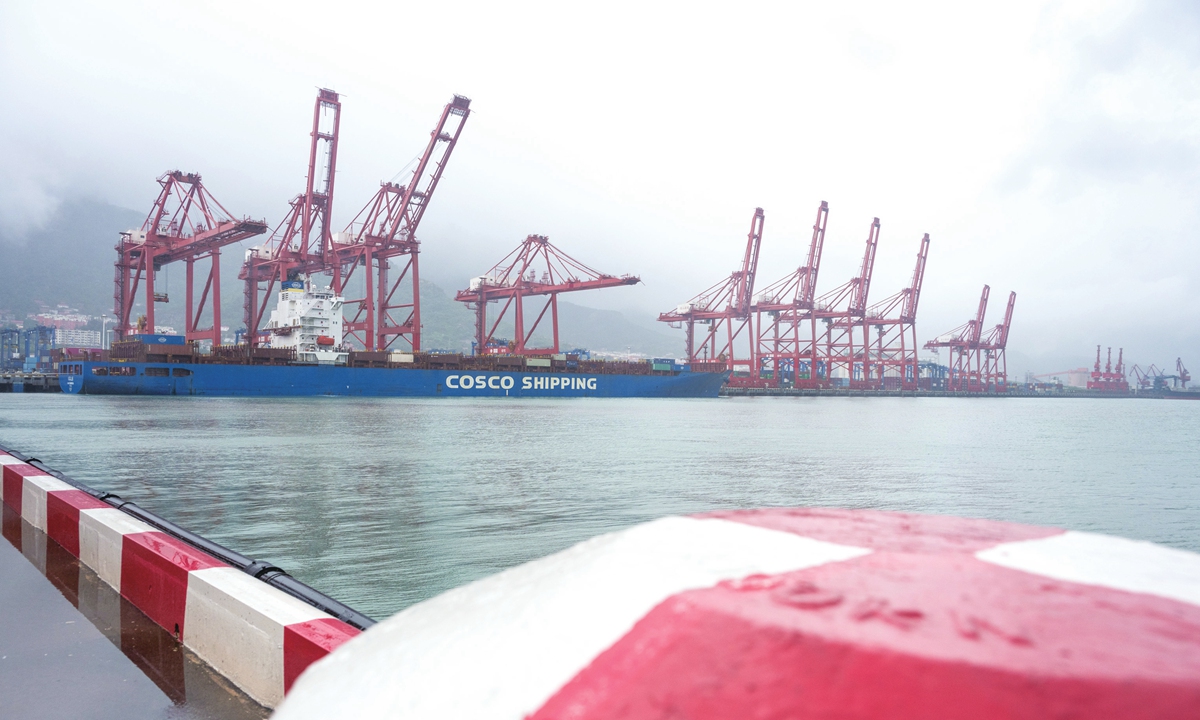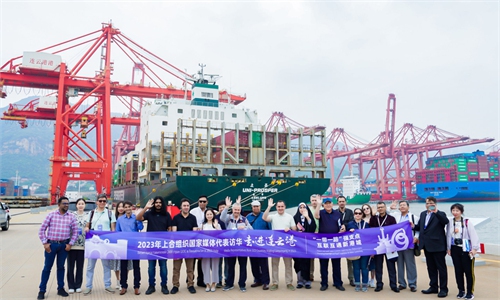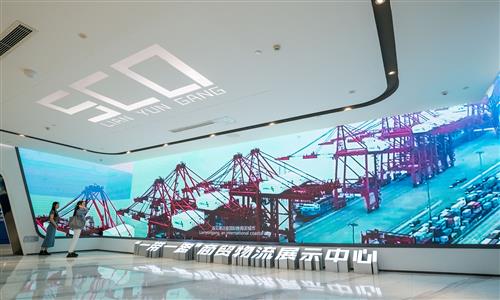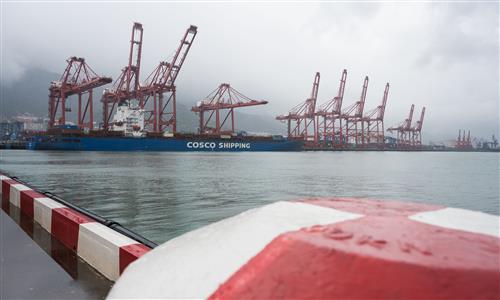Ten years on, E.China’s port bridges trade between Central and Southeast Asia under BRI


A view of the Lianyungang port in East China's Jiangsu Province Photo: Chen Tao/GT
How can a shipment of Kazakhstan ferrochrome alloy be transported to South Korea? The seemingly straightforward 14-day trip, now a regular choice for traders from both the two countries, involves a series of complex logistics arrangements.
The voyage begins with a rail journey, originating from major factories located in Aksu and Aktobe, Kazakhstan. From there, the shipment crosses borders and enters China through the bustling ports of Horgos and Alashankou, nestled in Northwest China's Xinjiang Uygur Autonomous Region.
Once within Chinese territory, the cargo makes its way eastward, heading toward the China-Kazakhstan International Logistics Base situated in the Lianyungang port of East China. At this crucial junction, meticulous arrangements are made to ensure the smooth transition of the shipment onto ships, which will carry it to its final destination, South Korea.
The ferrochrome alloy is just one of the vast products Kazakhstan-like Central Asian countries sent to Japan, South Korea and Singapore via the Lianyungang port, which has now become a key hub for the landlocked Central Asian countries to set sail from the Pacific Ocean.
So far, more than 80 percent of Kazakhstan's major trade commodities such as mineral products and grains are exported via the Lianyungang port. Meanwhile, electronic equipment and other favorable products from East Asia are also transported to Central Asian countries via the port, Du Anji, a representative of the Lianyungang New Silk Road International Container Development Co, told the Global Times.
"As of the end of May this year, there have been 154 trains transiting from Japan, South Korea, Southeast Asia and other regions to Central Asia and Europe, a year-on-year increase of 6.7 percent," Du said.
No longer landlocked
In the eyes of Zuo Xuemei, General Manager of Lianyungang China-Kazakhstan International Logistics Co, strengthened ties between the East China's port and Central Asia started from May 2014 when the China-Kazakhstan Lianyungang logistics project was officially put into operation witnessed by the heads of state of China and Kazakhstan.
It is also the first physical platform project under the China-proposed Belt and Road Initiative (BRI).
In the same year, the Lianyungang port authority set up a joint venture (JV) logistics company - Lianyungang China-Kazakhstan International Logistics Co - with KTZ Express, the logistics subsidiary of Kazakhstan Railways. The two sides hold a 51 percent stake and 49 percent stake, respectively.
After roughly ten years of development, the station, extending from Kazakhstan, has achieved full coverage of major sites in Central Asian countries. The transit time of international containers in Lianyungang has also been shortened from more than four days to less than one day, Zuo introduced.
Together with development of the station is economic and trade cooperation between China and the five Central Asian countries, namely Kazakhstan, Kyrgyzstan, Tajikistan, Turkmenistan and Uzbekistan.
Bilateral trade reached $70 billion in 2022, and it recorded a year-on-year expansion of 22 percent in the first quarter of this year, Shu Jueting, spokesperson for the Ministry of Commerce, told a press conference in May.
Apart from being a transfer link, Zuo said the port has also been seeking for expanding trade channel for the landlocked Central Asian nations. On February 5, 2017, Kazakhstan exported 720 tons of wheat to Vietnam via the logistics JV at Lianyungang port, opening up Southeast Asia for Kazakh agricultural produce.
Iskendirov Aziz, the vice general manager at Lianyungang China-Kazakhstan International Logistics Co, expressed his gratitude for the pivotal role played by the Lianyungang port in facilitating the export of wheat and other agricultural products from Kazakhstan to the Pacific region. In an interview with the Global Times, Aziz highlighted the increasing volume of exports via this route, emphasizing the port's significance in enabling the smooth flow of goods.
As demand for exports continues to surge, Aziz noted that efforts are underway to meet the growing needs of regional trade. The Lianyungang China-Kazakhstan International Logistics Co is actively pursuing additional train frequency to ensure that the current capacity aligns with the expanding export demand.
On March 14, the 5,000th Lianyungang China-Europe Railway Express departed from the China-Kazakhstan logistics base, starting its journey westward to Central Asia and marking another milestone for the base.
The route departing from Lianyungang has continued to operate in a stable manner even amid pandemic over the past several years, representing an important gateway and alternative for bridging the trade for Central Asia amid uncertainties, said Zuo.
An artery stretches to Europe
Due to its unique geographical location, though it places focus on connecting with Central Asia, Lianyungang has a long-time ambition of bridging a land-sea artery between Europe and Asia. Also known as the eastern bridgehead of the new Eurasian Land Bridge, the city firstly opened the international freight train business on December 1, 1992.
The dispatch of the locomotive, named as the "Dongfeng 1808" that heads to Central Asia and Europe, marked the beginning for the city to construct a new Asia-Europe land-sea combined transport channel, Sun Zian, chief editor of the news department at the Lianyungang Port Holdings Group Co, told the Global Times.
A real locomotive used as part of the opening ceremony is still displayed at the port to memorize the connection.
Over the past 31 years, the city has established six major logistic channels that link Lianyungang with five Central Asian countries, Mongolia, Kyrgyzstan-Uzbekistan, Russia, Turkey (across the Caspian Sea), and Germany. With Lianyungang as the central hub, this network seamlessly connects regions like Japan, South Korea, Southeast Asia with Central and Western Asia, as well as Europe, according to information provided by Lianyungang New Silk Road International Container Development Co.
This vast transportation network facilitates a constant flow of electronic products, new and used vehicles, machinery, and equipment from Japan, South Korea, Southeast Asia, and other regions to Central Asia and beyond. In return, it transports valuable resources such as minerals, grain, and fertilizers from Central Asia back to destinations like Japan, South Korea, and Southeast Asia, the company said.
"This robust connectivity strengthens trade relations along the entire rail transport route, bolstering economic interactions among the regions involved, and is indeed a representative of how BRI brings opportunities for countries, people and companies along the routes," Sun added.




